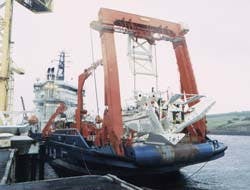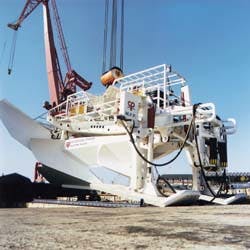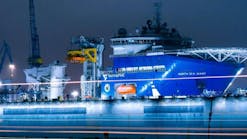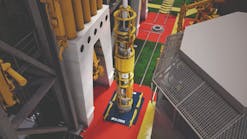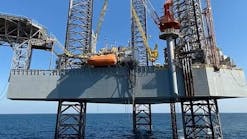PIPELINES Advanced plows prove worth on Lasmo, Shell trenching projects
Multipass plow deployment trials from the trenching support vessel Nordica.It is now just over seven months since Coflexip Stena Offshore took delivery of its new trenching and backfill plows from Soil Machine Dynamics. Since then the equipment has had a very active season in the North Sea with three major EPIC pipeline construction projects completed successfully. *
The new trenching system consists of the Multipass Plow (MPP) and the Backfill Plow (BFP). The MPP is the most sophisticated pipeline trenching plow currently available and represents the latest stage in the design evolution of the successful long-beam subsea plow concept.
"One of the most significant improvements compared with past plows is the low ratio of structural weight to strength (97 tonne in-air weight versus 250 tonne bollard pull capability) which helps to restrict ground bearing pressures, so that the plow can remain stable on soils with shear strengths as low as 5kPa," says Bill Hotchikiss, pipelines manager at Coflexip Stena Offshore. "The plows are further equipped with an air buoyancy system capable of reducing submerged weight to give 3kPa shear strength capability when required."
The MPP is also fully equipped to carry out excavation of a single trench in multiple passes and in this respect it is unique in current North Sea operations. The technique, known as multi-passing, allows a deeper trench to be excavated in strong or more difficult soils than would otherwise be possible in a traditional single pass.
In many circumstances this can actually result in a more rapid completion of the trenching programme. The ability to carry out rectification trenching also exists in cases where the first pass trench may be out of tolerance.
Use of the plow's moveable mouldboards on the first pass leaves flat tracks for the plow to follow on its second or subsequent passes. Extended reach pipe grab units are then capable of lifting the pipe up from the bottom of the trench and a new deeper trench can then be made.
Coflexip Stena Offshore's Multipass plow.
"The moveable mouldboards have been found to bring significant improvements to the quality of the trench, even when trenching in a single pass only," says Hotchkiss. "By pushing the excavated spoil away from the edge of the excavation wall a more stable trench is produced. Also, the tendency for spoil material to fall back into the trench is vastly reduced and a very clean and well defined profile results."
The excavation of as flat as possible trenches was critical to the concepts of all the pipeline trenching projects carried out during the projects undertaken this year. It was expected that the improved plow stability resulting from low ground pressures, and the improved trench and spoil heap stability from use of the moveable mouldboards, would both contribute directly to superior trench tolerances. As a contingency measure, the multi-passing technique could also be used to rectify any trench high spots.
In the event, the straightness record of the trenches excavated by the MPP has been very encouraging, although not totally without imperfection. Out of straightness incidents can never be completely eliminated as plows such as this will always be affected to a varying extent by the changes in soil conditions which occur along a pipeline route.
Although none of the projects carried out had a planned use of the plow's ability to second pass a trench using the multi-pass functions, this was in fact called upon on two occasions as contingency. In both cases the multi-pass operation was carried out successfully and fully achieved its objective.
One case involved the plow being brought to the surface for a replacement hydraulic part to be fitted. To ensure a continuous trench, all the multi-pass functions on the plow were utilized.
The moldboards were deployed in their fully extended configuration and the plow made the transition out of the trench. Once the repair was completed it was necessary to re-deploy the plow onto the pipeline approximately 50 metres prior to the end of the trench. From this point trenching begins again and in effect forms a multi-pass `overlap' by continuing along the original trench and into new ground.
On another project the MPP was used for pipeline trenching at a shallow site in the Southern North Sea. This project presented the plow with a number of sandwave obstacles to traverse and gave the pipeline engineers potential problems with the associated pipe free-spanning.
"In the event the trenching operation proved to be extremely successful," says Hotchkiss. "The MPP control system proved sufficiently responsive and pipeline loads remained well within allowable limits. Most pleasing also was the success the plow achieved in flattening out the feature and removing many pipe free-spans. This removed a significant potential dredging requirement from the workscope of the project."
The turning control of large plows such as the MPP is becoming of increasing importance as congestion within subsea development layouts increases and the use of plows in pre-cutting trenches for flexible pipelines and umbilicals to be laid into becomes more commonplace.
Because of this it was decided that it would be of great interest to perform a trial with the plow to investigate whether a trench could be excavated on a circle plan with a radius of 300 metres.
The test was duly carried out at a site with water depth of about 20 metres and it proved successful. Subsequently the bend radius was further reduced to 200 metres and again a uniform curve was produced. A stable and consistent trench was excavated at all points.
- The 1995 workscope comprised trenching of a 10-inch production line and a 12-inch line with 4-inch piggyback for Lasmo's Birch Field; trenching and backfilling of two 8.3km 8-inch production lines for Shell Pelican, as well as trenching of an 8-inch water injection line and a 6-inch gas lift line; and trenching 15.4km of a 14-inch gas line for Shell Barque.
Copyright 1996 Offshore. All Rights Reserved.

